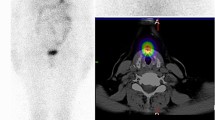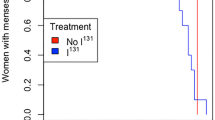Abstract
PHILLIPS1 has suggested that iodine-124 might prove more effective than iodine-131 in the treatment of cancer of the thyroid, largely because the greater energy of its β-rays should increase the amount of radiation administered from areas of functioning tumour to adjacent foci that do not take up iodine, We were therefore interested to compare experimentally the damaging effect on the thyroid of the two isotopes. The method used was that of Doniach and Logothetopoulos2, who showed that radiation damage to the thyroid of rats may be revealed by their loss of ability to produce goitres in response to a 10-day course of propylthiouracil when challenged 3–4 months after a single dose of iodine-131. Marked inhibition of goitrogenesis resulted from an intraperitoneal injection of 30 µc. of iodine-131. This dose gives a mean of about 12,000 rads to the rat thyroid with the very large range of about 2,000–24,000 rads, due to uneven uptake and distribution of iodine in the thyroid and loss of β-radiation from the gland periphery. It was found that the dose of external X-irradiation to the rat's thyroid necessary to inhibit the goitrogenic response to a degree equivalent to 30 µc. of iodine-131 was only 1,000 rads3. It is likely that part of the greater effectiveness of external X-irradiation over iodine-131 in terms of dosage is a reflexion of the uneven uptake of iodine and consequent comparative escape from iodine-131 radiation of less-actively functioning areas of thyroid. We thought that the radiation dose of iodine-124 necessary to inhibit goitrogenesis would be less than that of iodine-131 because its more penetrating radiation might even out the dosage throughout the thyroid gland, following Phillips's1 argument with regard to thyroid cancer.
This is a preview of subscription content, access via your institution
Access options
Subscribe to this journal
Receive 51 print issues and online access
$199.00 per year
only $3.90 per issue
Buy this article
- Purchase on Springer Link
- Instant access to full article PDF
Prices may be subject to local taxes which are calculated during checkout
Similar content being viewed by others
References
Phillips, A. F., Brit. J. Radiol., 30, 247 (1957).
Doniach, I., and Logothetopoulos, J. H., Brit. J. Cancer, 9, 117 (1955).
Abbatt, J. D., Doniach, I., Howard-Flanders, P., and Logothetopoulos, J. H., Brit. J. Radiol., 30, 86 (1957).
Dyson, N. A., and Francois, P. E., Phys. Med. Biol., 3, 111 (1958).
Mitchell, A. C. G., Juliano, J. O., Creager, C. B., and Kocher, C. W., Phys. Rev., 113, 628 (1959).
Girgis, R. K., and Van Lieshout, R., Physica, 25, 133 (1959).
Haybittle, J. L., Phys. Med. Biol., 4, 280 (1960).
Matthews, C. M. E., and Fowler, J. F., Nature, 186, 983 (1960).
Author information
Authors and Affiliations
Rights and permissions
About this article
Cite this article
DONIACH, I., FRANCOIS, P. Comparison of Iodine-124 and Iodine-131 in Inhibition of Goitrogenesis in the Rat. Nature 187, 704–705 (1960). https://doi.org/10.1038/187704a0
Issue Date:
DOI: https://doi.org/10.1038/187704a0
Comments
By submitting a comment you agree to abide by our Terms and Community Guidelines. If you find something abusive or that does not comply with our terms or guidelines please flag it as inappropriate.



